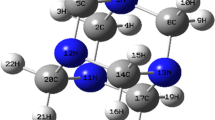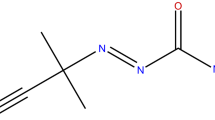Abstract
4-Amino-1,2,4-triazole picrate (4-ATPA) is a type of ionic liquids, as well as an explosive with sound thermal stability and low mechanical sensitivity. However, under upset conditions such as high temperature and pressure, an unpredictable explosion would occur and result in huge casualties and property losses. The purpose of this research was to evaluate the thermal hazard and runaway reaction of 4-ATPA through high-pressure differential scanning calorimetry and accelerating rate calorimeter. The kinetic parameters of decomposition reaction under non-isothermal and different pressure conditions were calculated based on the experiment results. Experimental results showed that the β and test pressure had no effect on the amount of heat release. Adiabatic experiments indicated that 4-ATPA had a high onset temperature at 196.8 °C. The maximum self-heating rate (3567.9 °C min−1) and pressure rise rate (202.0 bar min−1) revealed the vulnerability of 4-ATPA to suffer a disastrous explosion. Moreover, the apparent activation energy and pre-exponential factor were evaluated as 110.2 kJ mol−1 and 1.8 × 10−15 s−1 by ASTM E698 method. The correctness of the thermodynamic calculation formula under adiabatic conditions is verified by ARC tests. Finally, the thermal hazard risk of 4-ATPA was classified as unacceptable based on the risk classification criteria.









Similar content being viewed by others
Abbreviations
- A :
-
Pre-exponential factor (s−1)
- c :
-
Concentration (g cm−3)
- c 0 :
-
Initial concentration (g cm−3)
- C VB :
-
Heat capacity of bomb (J g−1 K−1)
- C VS :
-
Heat capacity of sample (J g−1 K−1)
- E a :
-
Apparent activation energy (kJ mol−1)
- k :
-
Arrhenius rate constant
- n :
-
Reaction order
- OB:
-
Oxygen balance (%)
- P max :
-
Maximum pressure (bar)
- (dP dt−1)max :
-
Maximum pressure rise rate (bar min−1)
- R :
-
Universal gas constant (8.314 J mol−1 K−1)
- r :
-
Rate of reaction (s−1)
- T onset :
-
Onset decomposition temperature (°C)
- T e :
-
End decomposition temperature (°C)
- T peak :
-
Peak decomposition temperature (°C)
- TMRad :
-
Time to the maximum rate (h)
- (dT dt−1)max :
-
Maximum self-heating rate (°C min−1)
- V :
-
Volume of the sample (m3)
- W p :
-
Peak power (W g−1)
- ΔHd :
-
Heat of decomposition (J g−1)
- ΔPad :
-
Adiabatic pressure rise (bar)
- ΔTad :
-
Adiabatic temperature rise (°C)
- α :
-
Degree of conversion
- β :
-
Heating rate (°C min−1)
- Φ:
-
Thermal inertia
References
Dong K, Liu X, Dong H, Zhang X, Zhang S. Multiscale studies on ionic liquids. Chem Rev. 2017;117(19):6636–95.
Parajó JJ, Teijeira T, Fernández J, Salgado J, Villanueva M. Thermal stability of some imidazolium [NTf2] ionic liquids: isothermal and dynamic kinetic study through thermogravimetric procedures. J Chem Thermodyn. 2017;112:105–13.
Sebastiao E, Cook C, Hu A, Murugesu M. Recent developments in the field of energetic ionic liquids. J Mater Chem A. 2014;2(22):8153–73.
Smiglak M, Metlen A, Rogers RD. The second evolution of ionic liquids: from solvents and separations to advanced materials-energetic examples from the ionic liquid cookbook. Acc Chem Res. 2007;40(11):1182–92.
Vogl T, Menne S, Kühnel RS, Balducci A. The beneficial effect of protic ionic liquids on the lithium environment in electrolytes for battery applications. J Mater Chem A. 2014;2(22):8258–65.
Mohammad Hossein K, Karim E, Mehdi Heidari S, Hedayatollah Z. A new method for assessment of glass transition temperature of ionic liquids from structure of their cations and anions without using any computer codes. J Therm Anal Calorim. 2017;1:1–19.
Lewandowski A, Świderska-Mocek A. Ionic liquids as electrolytes for Li-ion batteries—an overview of electrochemical studies. J Power Source. 2009;194(2):601–9.
Van Valkenburg ME, Vaughn RL, Williams M, Wilkes JS. Thermochemistry of ionic liquid heat-transfer fluids. Thermochim Acta. 2005;425(2):181–8.
Javed F, Ullah F, Zakaria MR, Akill HM. An approach to classification and hi-tech applications of room-temperature ionic liquids (RTILs): a review. J Mol Liq. 2018;271:403–20.
Yamaki N, Shiota K, Izato Y, Miyake A. Analysis of the thermal hazards of 1-butyl-3-methylimidazolium chloride mixtures with cellulose and various metals. J Therm Anal Calorim. 2018;133(1):797–803.
Sikder A, Geetha M, Sarwade D, Agrawal J. Studies on characterisation and thermal behaviour of 3-amino-5-nitro-1, 2, 4-triazole and its derivatives. J Hazard Mater. 2001;82(1):1–12.
Lee KY, Storm C, Hiskey M, Coburn M. An improved synthesis of 5-amino-3-nitro-1 H-1, 2, 4-triazole (ANTA), a useful intermediate for the preparation of insensitive high explosives. J Energ Mater. 1991;9(5):415–28.
Tian T, Hu X, Guan P, Wang S, Ding X. Density and thermodynamic performance of energetic ionic liquids based on 1-alkyl/esteryl-4-amino-1, 2, 4-triazolium. J Mol Liq. 2017;248(17):70–80.
Xiang D, Zhu W. Thermal decomposition of isolated and crystal 4, 10-dinitro-2, 6, 8, 12-tetraoxa-4, 10-diazaisowurtzitane according to ab initio molecular dynamics simulations. RSC Adv. 2017;7(14):8347–56.
Kowhakul W, Inoue D, Nakagawa Y, Masamoto H, Shigematsu M. Thermal decomposition mechanisms of 1H-1, 2, 4-triazole derivatives: a theoretical study. J Loss Prev Process. 2017;50:37–54.
Singh D, Sharma G, Gardas RL. Exploration of the solvation behavior of ascorbic acid in aqueous solutions of 1, 2, 4-triazolium based ionic liquid. J Mol Liq. 2017;244:55–64.
Pagoria P. A comparison of the structure, synthesis, and properties of insensitive energetic compounds. Propellants Explos Pyrotech. 2016;41(3):452–69.
Keshavarz MH, Rahimi R, Akbarzadeh AR. Two novel correlations for assessment of crystal density of hazardous ionic molecular energetic materials using their molecular structures. Fluid Phase Equilib. 2015;402:1–8.
Sasidharan N, Hariharanath B, Rajendran A. Thermal decomposition studies on energetic triazole derivatives. Thermochim Acta. 2011;520(2):139–44.
Tsai YT, Liao JY, Shu CM. Explosion characteristics of chlorodifluoromethane and isobutane at high temperature and pressure using a 20-L apparatus. Int J Refrig. 2018;96:155–60.
Wang SW, Yang L, Feng JL, Wu BD, Zhang JG, Zhang TL, Zhou ZN. Synthesis, crystal structure, thermal decomposition, and sensitive properties of two novel energetic cadmium (II) complexes based on 4-amino-1, 2, 4-triazole. Z Anorg Allg Chem. 2011;637(14):2215–22.
Özdemir MC, Özgün B. Tunable aryl alkyl ionic liquids (TAAILs) based on 1-aryl-3, 5-dimethyl-1H-pyrazoles. J Mol Liq. 2017;248:314–21.
Haasnoot JG. Mononuclear, oligonuclear and polynuclear metal coordination compounds with 1, 2, 4-triazole derivatives as ligands. Coord Chem Rev. 2000;200:131–85.
Klingele MH, Brooker S. The coordination chemistry of 4-substituted 3, 5-di (2-pyridyl)-4H-1, 2, 4-triazoles and related ligands. Coord Chem Rev. 2003;241(2):119–32.
Tsai YT, Huang AC, Ho SC, Shu CM. Potential explosion hazard of polyester resin dust formed from a granulation process: limiting oxygen concentration with different pressures. Appl Therm Eng. 2018;135:74–82.
Tsai YT, Liao JY, Shu CM. Explosion characteristics of chlorodifluoromethane and isobutane at high temperature and pressure using a 20-L apparatus. Int J Energy Res. 2018;96:155–60.
Liu SH, Shu CM. Advanced technology of thermal decomposition for AMBN and ABVN by DSC and VSP2. J Therm Anal Calorim. 2015;121(1):533–40.
Liu SH, Yu YP, Lin YC, Weng SY, Hsieh TF, Hou HY. Complex thermal evaluation for 2, 2′-azobis (isobutyronitrile) by non-isothermal and isothermal kinetic analysis methods. J Therm Anal Calorim. 2014;116(3):1361–7.
Chiang CL, Liu SH, Lin YC, Shu CM. Thermal release hazard for the decomposition of cumene hydroperoxide in the presence of incompatibles using differential scanning calorimetry, thermal activity monitor III, and thermal imaging camera. J Therm Anal Calorim. 2017;127(1):1061–9.
Wu SH, Lin ML, Shu CM. Thermal hazard evaluation of tert-butyl peroxide using non-isothermal and adiabatic calorimetric approaches. J Therm Anal Calorim. 2012;109(2):975–80.
Vyazovkin S, Wight CA. Model-free and model-fitting approaches to kinetic analysis of isothermal and nonisothermal data. Thermochim Acta. 1999;340:53–68.
Sivapirakasam S, Mohamed MN, Surianarayanan M, Sridhar V. Evaluation of thermal hazards and thermo-kinetic parameters of a matchhead composition by DSC and ARC. Thermochim Acta. 2013;557:13–9.
Wang TS, Liu SH, Lin YC, Chen YC, Shu CM. Green process of propylene oxide reaction for thermal hazard assessment by differential scanning calorimetry and simulation. Chem Eng Technol. 2015;38(3):455–62.
Zhang L, Yu D, Pan XH, Fang JJ, Hua M, Chen FM, Jiang JC. Thermal hazard assessment for synthesis of 3-methylpyridine-N-oxide. J Loss Prev Process Ind. 2015;35:316–20.
Zhang Y, Ni L, Jiang JC, Jiang J, Zhang W, Jiang JJ, Zhang M. Thermal hazard analyses for the synthesis of benzoyl peroxide. J Loss Prev Process Ind. 2016;43:35–41.
Acknowledgements
The authors would like to express their appreciation to the Anhui Provincial Natural Science Foundation, China, for its financial support under contract number 1908085ME125 for financial support of this study.
Author information
Authors and Affiliations
Corresponding author
Additional information
Publisher's Note
Springer Nature remains neutral with regard to jurisdictional claims in published maps and institutional affiliations.
Rights and permissions
About this article
Cite this article
Zhang, ZH., Liu, SH., Zhang, B. et al. Runaway reaction and thermal hazards simulation of 4-amino-1,2,4-triazole picrate by HP-DSC and ARC. J Therm Anal Calorim 139, 1367–1377 (2020). https://doi.org/10.1007/s10973-019-08529-6
Received:
Accepted:
Published:
Issue Date:
DOI: https://doi.org/10.1007/s10973-019-08529-6




